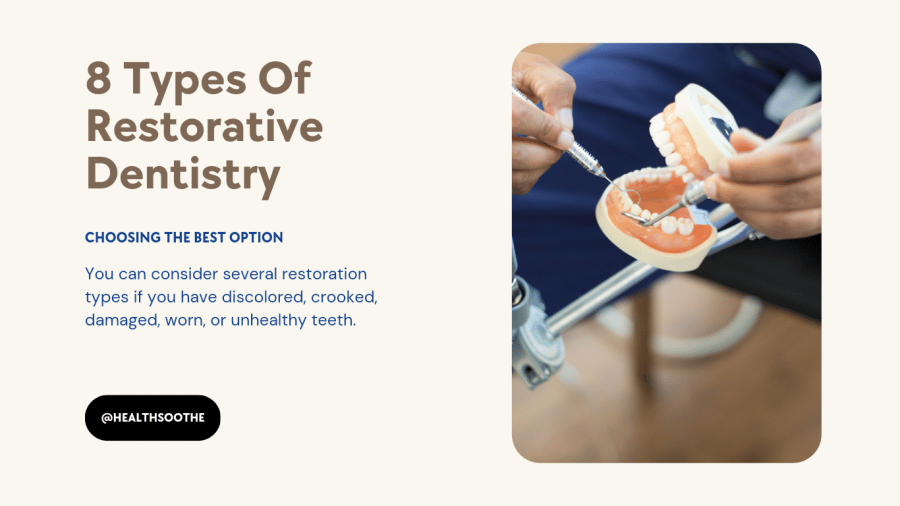Restorative dentistry is restoring the jaw, gum, and teeth to a healthy state to preserve long-term oral health. If you suffer from missing or damaged teeth, restorative dentistry can work in various ways to give you a more confident smile. Other problems like tooth sensitivity, pain, and difficulty chewing can be restored using these procedures. Fillings, bridges, crowns, root canals, and implants are the most common restorative options that a dentist can do for you.
Many people suffer from complications and dental problems such as tooth decay and are unaware of it. According to the Centers for Disease Control and Prevention (CDC), about 80% of adults 1https://www.cdc.gov/nchs/data/databriefs/db96.pdf get one or more restorative procedures in their lifetime. You can consider several restoration types if you have discolored, crooked, damaged, worn, or unhealthy teeth. Keep reading to learn about the various restorative procedures you can choose.
1. Dentures
Dentures are a perfect way to bring back your smile if you have more than one missing tooth. Full dentures will restore your smile if you miss all the teeth on your upper and lower jaw. For a person missing a portion of their teeth, the partial dentures can be placed while the rest of the original teeth remain. Cosmetic dentures are more advanced and are designed to fit comfortably and securely.
2. Root canal
Root canal therapy is ideal when a crack or cavity goes deep into your teeth to reach the pulp. It is a rather detailed procedure where your dentist will remove the diseased pulp, including the blood vessels and tiny nerves of your tooth. The inside surfaces of your tooth are thoroughly cleansed and filled with a rubbery dental material. A filling is then placed to seal the tooth and hinder bacteria from entering. Most people that undergo root canals also need a crown for additional strength and support.
3. Dental fillings
Dental fillings are common restoration procedures. Bacteria sometimes eat away at the tooth enamel, causing a hole called a cavity. Small cavities can be repaired using dental fillings. The procedure involves the removal of the decaying portion of the tooth and using a tooth-colored composite material to fill the hole. Dental fillings stop the progression of tooth decay and minimize the risk of further damage.
4. Inlays and onlays
Inlays and onlays are used for cavities that are not fit for a filling and too small for a crown. Inlays fill the area between teeth cusps, while onlays cover at least one cusp. These custom-made restorations are designed to fit into your original tooth like jigsaw puzzle pieces. Once they are placed in their appropriate position, your dentist permanently bonds them.
5. Dental crowns
Dental crowns are custom-made to fit your smile by covering the existing teeth or replacing the missing teeth. These tooth-colored crowns are color-matched to blend naturally with your smile. They help restore the appearance of your existing teeth and preserve them for many more years. Dental crowns are used with implants or dental bridges to restore the missing teeth in your mouth.
6. Dental implants
Another great restorative option available for missing teeth is the dental implant. It is a proven process to remedy tooth loss and can provide lasting restoration for one or more missing teeth. If you take good care of implants, they can last a lifetime.
7. Dental bridges
Dental bridges are the ideal restorative procedure if you are missing one or more teeth. Dental bridges are attached to a tooth on either side to form a secure location where dental crowns are placed to replace your missing teeth. They are an effective way of filling the gaps in your smile and can be placed in just a few visits to your dentist.
8. Dental bonding
Dental bonding is ideal when you have chipped, damaged, or misshapen teeth. Bonding has the tooth color, and it adheres directly to the tooth. Your dentist shapes the bonding to resemble the appearance of your original tooth. Dental bonding can last several years with proper care, and it is made to withstand the normal use of your original teeth.
Final words
Knowing the best type of dental restoration can be difficult because of the many great options out there. It would be best to consult your dentist, who can evaluate your teeth and recommend the ideal procedure for you.
When you schedule a consultation with your dentist, you can ask questions about the available options. The first thing you should do is familiarize yourself with the available procedures before making a decision.
Additional resources and citations
- 1https://www.cdc.gov/nchs/data/databriefs/db96.pdf



